You're Hyundai. Pickups are top sellers in North America, so you want to offer one. But Toyota and Nissan haven't done well going head-to-head with Detroit. And Honda hasn't done any better with the unibody Pilot-based Ridgeline. So, what do you do? Seeking a segment all to yourself, you go smaller, sportier, and less expensive than the Ridgeline...but spend enough years fine-tuning your design (a concept was shown back in January 2015) that Ford will soon also offer a compact crossover with an open bed.
Hyundai wants everyone to know that they did not design the Santa Cruz to do pickup stuff like hauling large loads, towing, or off-roading as well as conventional pickups. It's not intended for job sites, but for camp sites (and other outdoor activities). In this "sport adventure vehicle" role the Santa Cruz, which is closely related to the redesigned-for-2022 Tucson, should serve the same buyers that compact crossovers have been serving, just with an open bed in place of an enclosed cargo area.
Ford likely had a similar buyer in mind with the forthcoming Maverick, which is closely related to the Escape and Bronco Sport compact crossovers. Does the Santa Cruz possess enough advantages that the Maverick won't impede its success? Or did Hyundai take too long deciding what sort of pickup to offer and still not end up with the best answer? I haven't driven the Maverick yet, so my comparison won't be complete, but a day spent with the Santa Cruz suggests what Hyundai got right and what they might have done differently.
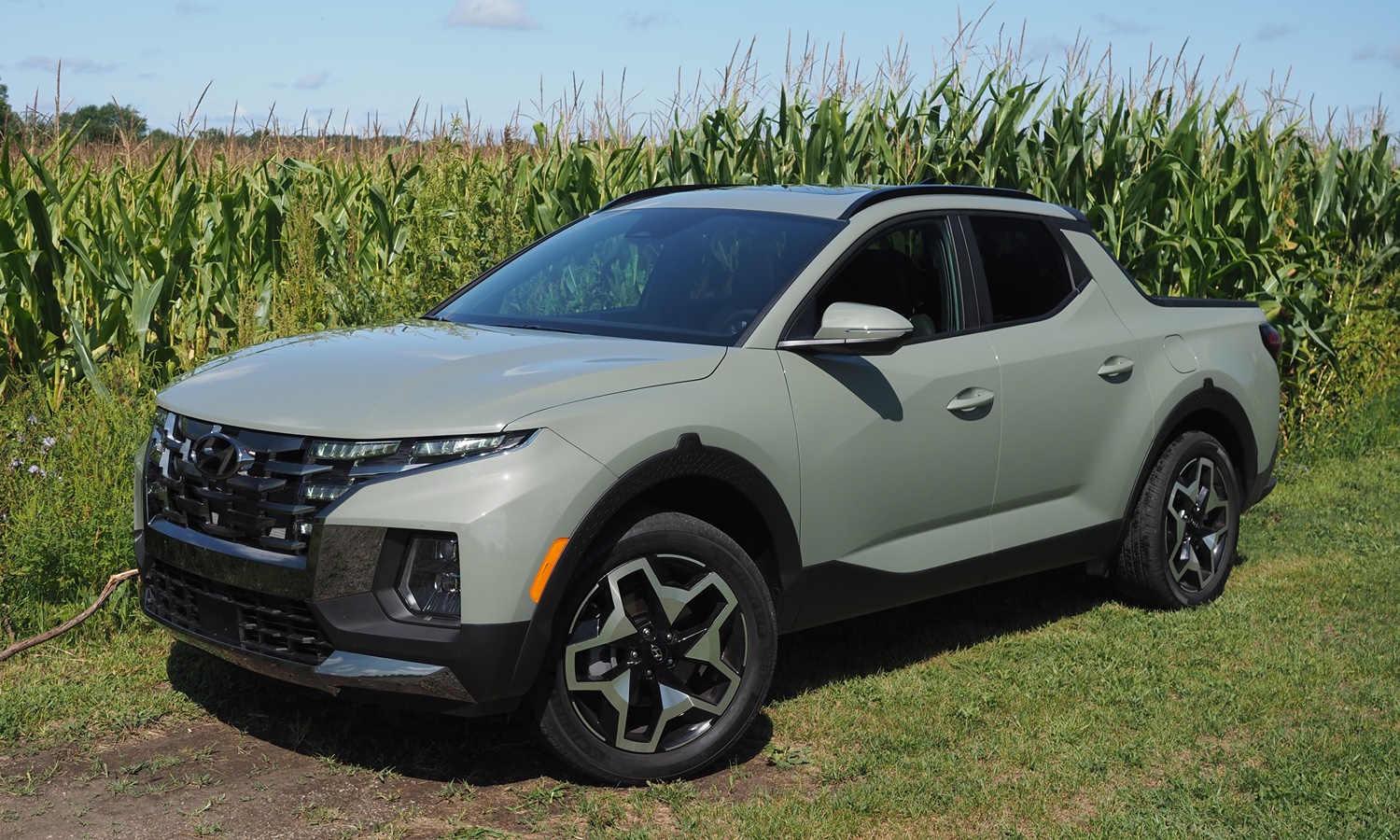
Did Hyundai go too round with the front end styling and wheel openings? more Santa Cruz photos
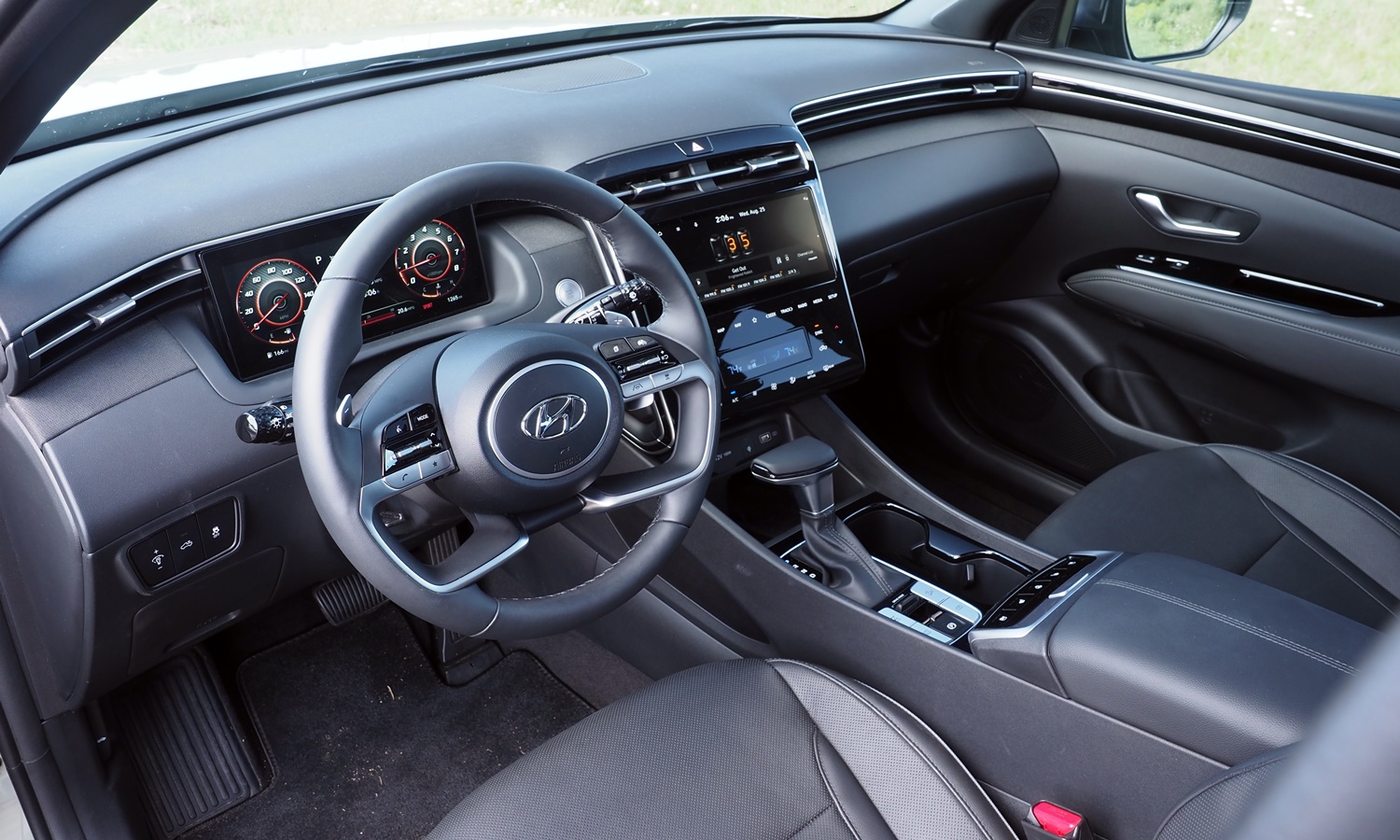
Does this interior styling say "sport adventure vehicle" to you?
| |
Compared to the Maverick |
| Feature availability |
 Better
Worse
Better
Worse
|
Who has made the best bed, Ford with decades of previous experience or Hyundai with none? In some ways, Hyundai. While Ford offers bedliners (spray-in or drop-in) as options, Hyundai has made a scratch-and-dent-resistant composite bed standard. The upper trim levels of the Santa Cruz include a self-retracting lockable metal tonneau, for secure storage. Ford offers a few different bed covers as optional accessories, but none as slick as Hyundai's. Only the Santa Cruz has a Ridgeline-like lockable underfloor storage compartment with a pair of drain plugs so it can be used as a cooler and easily washed out.
Both beds include a variety of tie-down points, though only Hyundai includes tracks to make some adjustable on the base trim. Both have perches for 2x4s or 2x6s to support a second layer of cargo. Both have tailgates that can be set at an angle so their tops are even with the tops of the wheel wells, to flat carry 4x8 sheets of plywood. Both can have storage compartments in their sidewalls, but only Hyundai makes two of them standard on even the base trim. On the Maverick, the XL has no compartments, the XLT has one, and only the Lariat has two. Similarly, Hyundai includes an AC power outlet in one of the compartments on two trim levels and makes it optional on a third, while Ford offers this feature only as part of an option package on the top-trim Lariat.
The Hyundai bed does have one clear shortcoming: it's a few inches shorter than the Maverick's 54.4. How many depends on where you measure: only two at the floor, but a half-foot at the top of the bed. This reflects some design decisions. First, in the interest of maneuverability, Hyundai made its truck shorter, 196 vs. 200 inches, on a shorter wheelbase, 118 vs. 121 inches. Second, Hyundai angled the rear wall of its cab to permit a more reclined rear seat whily minimally compromising bed length. (According to Hyundai, the rear seatbacks in pickups tend to be uncomfortably vertical.) In trucks with the tonneau, the box into which it retracts takes up another half-foot at the top of the bed. Whether the remaining space is sufficient will depend on what you want to carry. For large mountain bikes you'll likely need a rack.
The Ford's cargo floor is a little closer to the ground (30.1 vs. 31.6 inches) and its bed is a little deeper (20.3 vs. 19.2 inches).
Inside the cab, both trucks have storage bins beneath the rear seats. The Hyundai's bins can be removed to open up space for larger cargo--but tire-changing hardware occupies the one on the right.
Beyond the bed, the Santa Cruz offers a few features the Maverick does not, including nav, an around-view camera system, leather seating surfaces, and ventilated front seats. But if you want a power-slidng rear window or a full-size spare, only Ford offers these.
The two trucks are styled so differently that many buyers will strongly prefer one look or the other.
Seeking to offer a pickup for people who would otherwise buy a crossover, Hyundai opted for car-like curves, bulging fenders and rocker panels, a sportily raked rear pillar, and (on the Limited) big 20-inch wheels. Have they gone too round with the nose and wheel openings? One neat detail on the Hyundai I didn't initially notice: two character lines merge into one on the front door. A similar cue is present on the new Elantra, but it fits the overall design much better on the Santa Cruz.
In sharp contrast, Ford styled its new small truck like its larger trucks, so the Maverick is much squarer. In line with this less sporty but more rugged theme, the largest wheels offered on the Maverick are 18s.
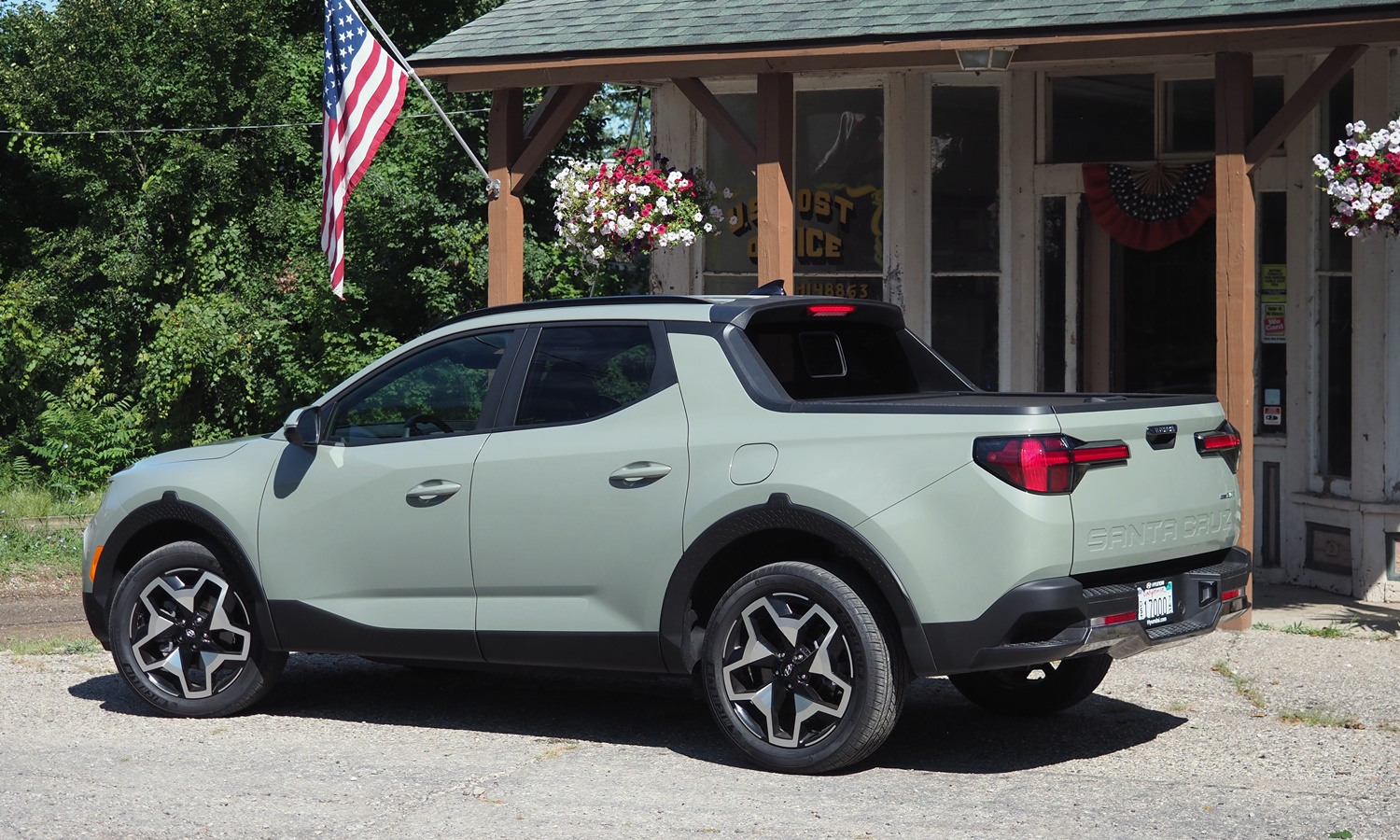
The rear half works better than the front half. Sporty rake to the rear pillars.
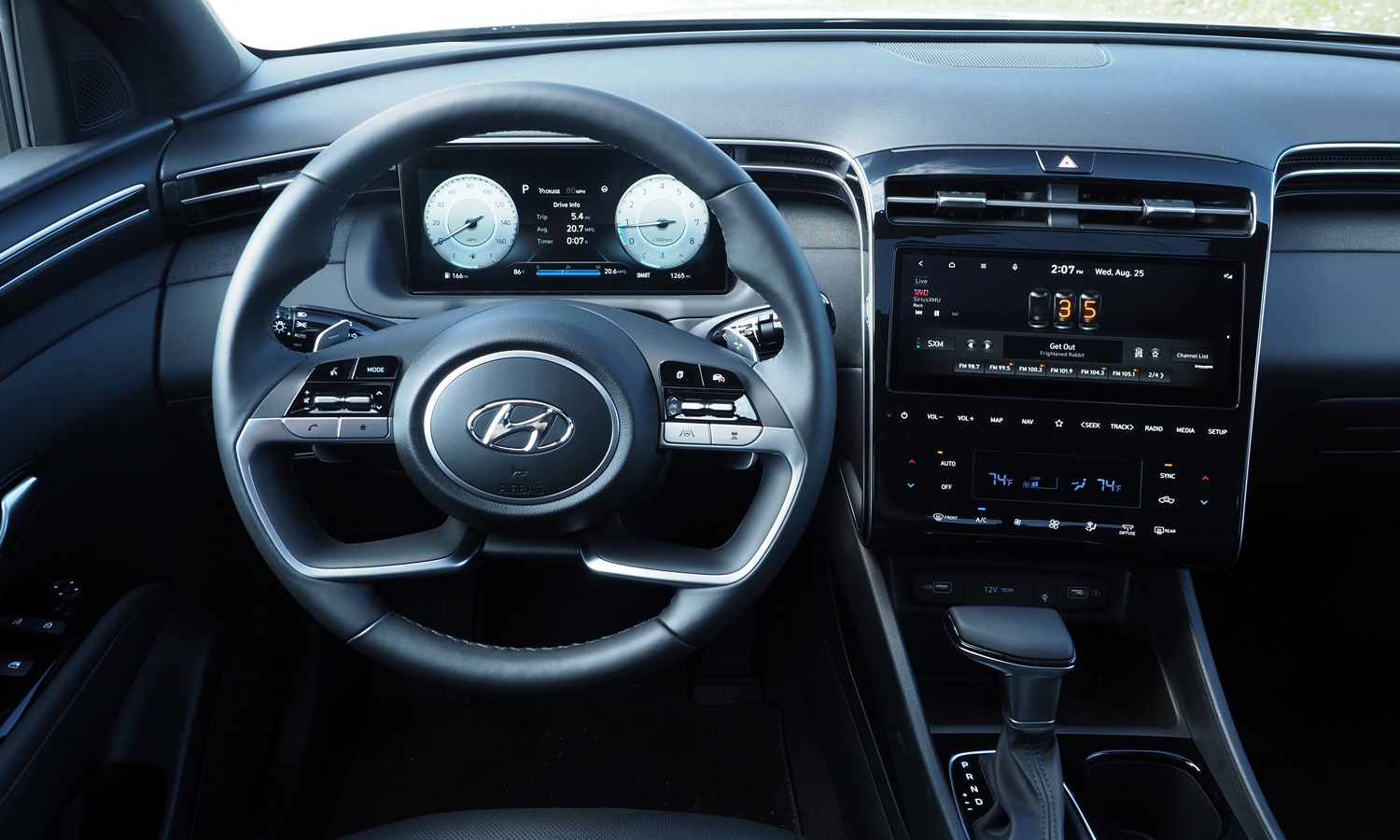
Undersized LCD instruments require no bump in the instrument panel.No knobs or even physical buttons
| Powertrain performance |
 Better
Worse
Better
Worse
|
In SE and SEL trim the Hyundai Santa Cruz is powered by a 191-horsepower 2.5-liter four-cylinder engine paired with an eight-speed automatic transmission. Alas, these have just started leaving the factory, so none were available at the media event. With the SEL Premium and Limited, the engine gains a turbo and 90 horsepower, for a total of 281, and the transmission is a quicker-shifting eight-speed DCT. Care more about low-end grunt? The 2.5T engine can dish out 311 lb-ft of twist as low as 1,700 rpm.
This is the same powertrain fitted to the performance-oriented Sonata N Line sedan. A Santa Cruz Limited with all-wheel-drive weighs considerably more than a Sonata--4,123 pounds--but is nonethless quite quick for this sort of vehicle. Need to get from a dead stop to 60 mph in under seven seconds? With the turbo engine, the Santa Cruz can accomplish this. Sadly, while the engine feels powerful it sounds like a pedestrian four-cylinder; not hard on the ears, but not music, either.
The Ford Maverick with its optional turbocharged engine could be about as quick. This engine is smaller (2.0 liters) with fewer horsepower (250), but it has about 400 fewer pounds to accelerate. It does not appear that Ford will provide a way to manually select among the automatic's eight speeds. The Santa Cruz's DCT can be manually shifted using either paddles or a console-mounted shifter.
I wavered on whether to include handling among the reasons to buy a Hyundai Santa Cruz. Compared to conventional pickups, the Santa Cruz handles with greater agility, precision, and composure. "Sport mode" tightens up the steering nicely (but will also harm fuel economy unless you manually select higher gears). But compared to compact crossovers its handling is nothing special, with a tendency towards understeer and limited grip from the comfort-oriented Michelin Primacy LTX tires despite their 245mm girth.
I haven't yet driven the Maverick, so I don't know how its handling compares.
To Hyundai's credit, it specced even the base front-drive Santa Cruz with a multilink rear suspension and self-leveling shocks. The latter enable a ride that is neither overly stiff when unloaded nor insufficiently firm when fully loaded. Ride quality that is merely good by compact crossovers standards rates as excellent by midsize pickup standards. I noted minor bumpiness at low speeds, but otherwise the ride was smooth even with the Limited's 20-inch 50-series tires.
With the Maverick, a multilink rear suspension is only included with all-wheel-drive. Self-leveling rear shocks don't appear to be offered, so the suspension is either stiffer to compensate, sags more when the bed is loaded, or both.
| |
Compared to the Maverick |
| Price or payments |
 Better
Worse
Better
Worse
|
Ford surprised Hyundai a bit by making its crossover-based pickup a bit longer, and much more by pricing it much lower. In the past small pickups sold in large numbers because they were cheap, and Ford might have figured that a low price would be essential to the Maverick's success. A starting price of $19,995 (plus $1,495 destination) despite a standard hybrid engine didn't only surprise Hyundai, but pretty much everyone who pays attention to such things. This noted, don't expect to find $21,490 Mavericks on dealer lots; word is they'll only be available to order. The Santa Cruz starts nearly $4,000 higher, at $25,175.
Load both trucks up, and the Santa Cruz's price remains higher but becomes more defensible. The tested Santa Cruz listed for $41,500. A similarly optioned Maverick will list for $37,260. The Santa Cruz Limited includes features you cannot get on the Ford: a composite bed, 20-inch wheels, navigation, leather seating surfaces (vs. "high-quality synthetic leather"), ventilated front seats, and an around-view camera system. The Maverick counters with its own exclusive features: a trailer hitch (available as an accessory on the Hyundai), a power-sliding rear window, and a full-size spare. Factor in the Hyundai's plusher interior materials and longer standard warranty--five years instead of three, plus ten on the powertrain for the first owner--and its higher price might seem justified.
Toss the $37,715 to $45,145 Honda Ridgeline into the mix, and the Hyundai might seem inexpensive.
Additional features only have value if you personally want them. More features are available as individual options on the Maverick. If you want the turbo engine, you can add it to even the base truck for just $1,085, for a total of $22,575. Also want all-wheel-drive? A $24,795 list price remains below the Santa Cruz's starting price with no turbo and front-wheel-drive. Or, if you don't want a sunroof, you don't have to get one even in an otherwise heavily optioned truck. On the Hyundai, if you want the turbo engine or the self-retracting bed cover you'll have to also pay for a sunroof (and a bunch of other stuff). Until the turbo engine is offered with front-wheel-drive, the least expensive 281-horsepower Santa Cruz lists for $36,865--$12,000 more than the turbo AWD Maverick.
| Fuel economy |
 Better
Worse
Better
Worse
|
Even with the non-turbo engine the Hyundai Santa Cruz manages only 21 mpg city and either 26 mpg (FWD) or 27 mpg (AWD) highway in the EPA's testing. With the turbo engine and AWD it scores 19/27, not much better than the larger, 4,436-pound Honda Ridgeline's 18/24. My real-world driving suggests that the Hyundai's highway figure is optimistic. In driving on rural roads and highways with some heavy-footed acceleration but much steady-speed cruising the trip computer reported an even 20 mpg. In straight highway driving it reported about 23 mpg.
The Ford Maverick might manage no better with its own turbocharged engine. But Ford will also offer its truck with a hybrid powertrain claimed to be good for 40 mpg in the EPA's city cycle. (Note: the hybrid will only be available with front-wheel-drive.)
Hyundai could offer the Santa Cruz with a hybrid engine fairly easily; the closely related Tucson crossover is already offered in hybrid form. EPA mpg with standard AWD: 38. But will Hyundai do this?
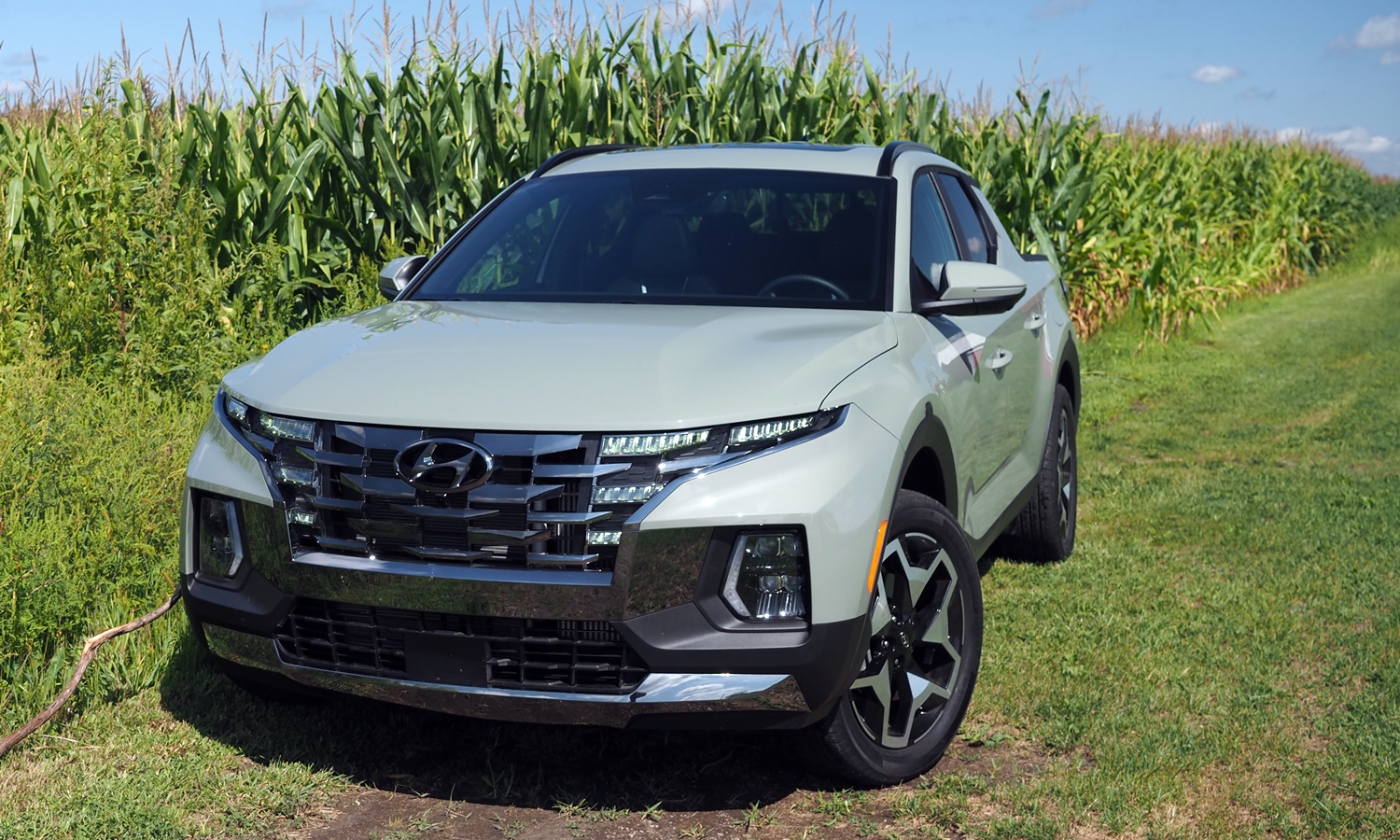
Fancy face full of LEDs.
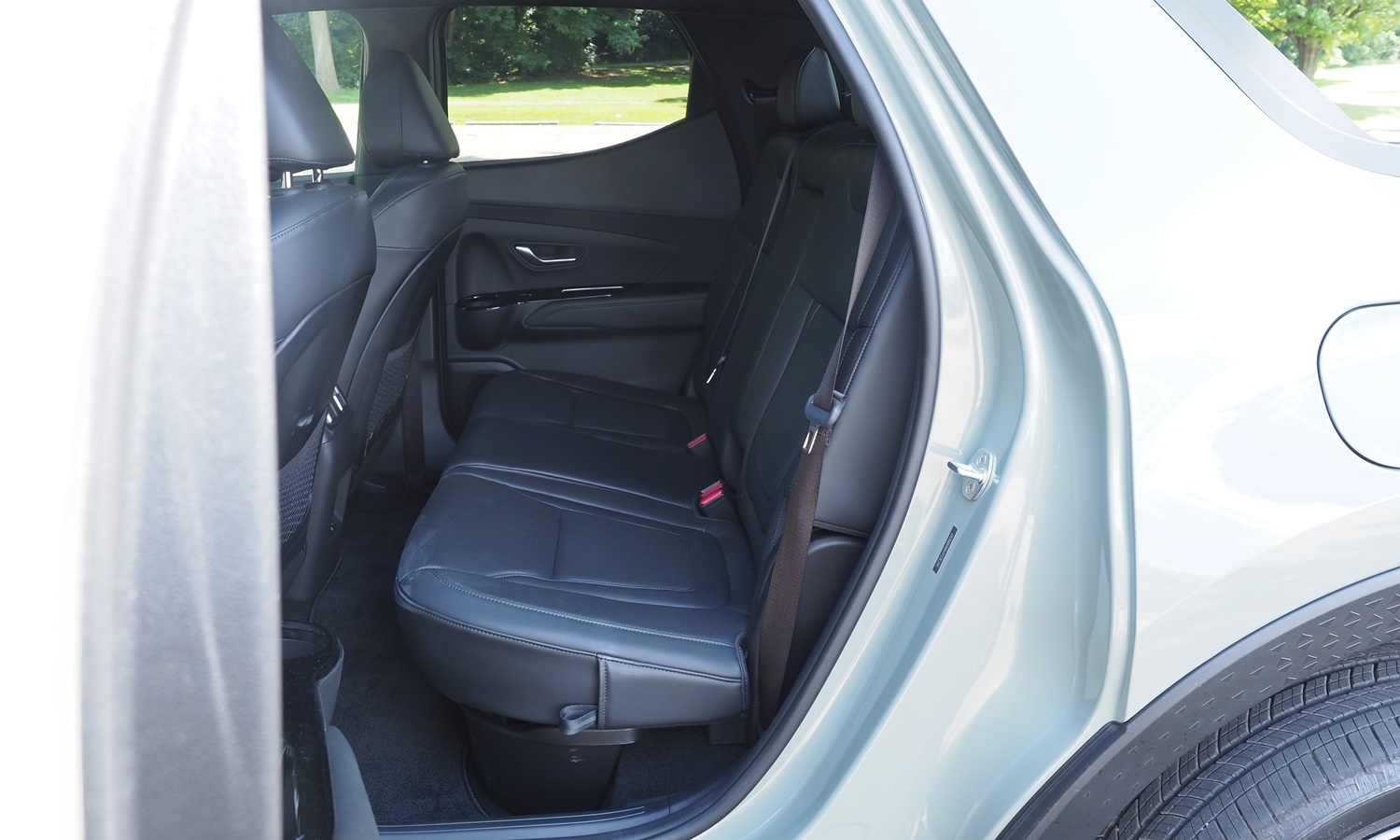
Marginal rear knee room. Front seat set for a 5-9 driver.
| Interior styling |
 Better
Worse
Better
Worse
|
Styling is of course subjective, but to my eyes the Santa Cruz's instrument panel--shared with the Tucson--looks out of place in a truck, even one seeking to appeal to crossover owners. The curvy forms and flat-topped instrument panel resemble those in 1990s Buicks. The LCD panels, one for the instruments and another for the infotainment, appear much more modern, but no more in character for a "sports adventure vehicle." The corporate reconfigurable LCD instrument cluster looks quite upscale in the relatively inexpensive Elantra sedan. But it's a bit smaller than it should be in all of an increasing number of Hyundai and Kia models. Chrome-edged strips of piano black trim on the doors wouldn't look out of place in a Mercedes, but also don't fit the Santa Cruz's desired character. Interior colors are limited to black or gray.
The Ford Maverick's interior includes considerably more hard plastic than the Hyundai's, but appears much more outdoor adventure-oriented. Upholstery in the top-trim Lariat is a warm brown, while that in the mid-level XLT is a blue and gray combination.
| Controls and instruments |
 Better
Worse
Better
Worse
|
Before I pick some additional nits, I'll note that Hyundai fitted the Santa Cruz with a conventional shifter. Such a shifter remains much more intuitive and easy to use on the fly than the buttons in the related Tucson and the dial in the Ford.
Now the nits. In the Santa Cruz Limited, all of the HVAC and infotainment system controls are capacitive touch or on-screen virtual buttons. None can be found and operated by feel. Unlike in the Ford Maverick, there are no knobs. The heating or ventilation level of the seats is selected using physical buttons, but these are located so far rearward that they're dangerous to view while driving.
These faults noted, the Santa Cruz's controls are otherwise logically laid out and easy to navigate, as Hyundai's controls tend to be.
| Driving position & visibility |
 Better
Worse
Better
Worse
|
The Santa Cruz's roof is two inches lower than the Maverick's, but it's instrument panel is fairly tall, so the view forward from the driver seat isn't as wide open as in the Maverick or in the typical pickup truck. This might be good if you want a relatively car-like driving position and view forward, but isn't otherwise.
| |
Compared to the Maverick |
| Front seat support & comfort |
|
Judging from the specs, the Hyundai Santa Cruz and Ford Maverick are about equally roomy. The Santa Cruz's front seat feels fairly spacious, and the seat itself provides good support. I appreciated the powered ventilation--not available on a Ford--on a hot day.
| Rear seat room & comfort |
 Better
Worse
Better
Worse
|
To make the Santa Cruz out of the Tucson, Hyundai didn't simply replace the enclosed rear cargo area with an open bed. To minimize overall length (which still ended up 13 inches over the Tucson's), Hyundai also reduced the length of the passenger compartment, shrinking rear legroom by a considerable five inches. With the reduction, rear legroom can be marginal (or worse) behind a tall driver in the Santa Cruz. Sitting behind my 5-9 self, my knees were just a few inches from the front seatbacks.
I haven't included this as a reason not to buy the Santa Cruz because legroom in the Maverick with the turbo engine is about the same. (Note that Ford cheats when calculating its legroom specs, so two inches must be subtracted from the Maverick's front legroom spec when compariing it to those of competitors.) The hybrid Maverick has an inch less rear legroom than the turbo, so it's a bit tighter. Though the Honda Ridgeline is a much larger vehicle, with a considerably broader cab, because much of its additional length (210 inches, vs. 196 and 200) enables a 60-inch-long bed it offers no more legroom than the Hyundai or the Ford.
The other interior dimensions of the two trucks also differ by less than an inch--somewhat surprising since they were developed concurrently, with neither team able to copy the other's work. The Hyundai has a wider exterior, but the additional 2.2 inches enable more muscular fenders, not more interior room.
Aside from the marginal rear legroom, I found the Santa Cruz's rear seat to be comfortable. It's positioned high enough off the floor to provide thigh support and its seatback isn't overly upright. According to Hyundai, the rear seats in conventional midsize pickups tend to be much less comfortable.
| Towing |
 Better
Worse
Better
Worse
|
Hyundai rates the Santa Cruz to tow 5,000 pounds with the turbo engine and AWD, tying the Ridgeline, 3,500 pounds otherwise. Ford rates the Maverick to tow only 2,000 pounds. To tow 4,000, still less than the Hyundai's max, you must spring for a $745 option package. As Hyundai readily concedes, conventional pickups can usually be specced to tow significantly more than these crossover-based trucks.
Working independently, Hyundai and Ford ended up with two trucks that look very different but that are functionally quite similar. Either should serve the intended "active lifestyles" market well, combining crossover-like performance, handling, and ride quality with additional cargo versatility. The Ford's bed is a little longer, but the Hyundai's includes more innovative features, especially on the lower trim levels. The Santa Cruz's underfloor storage compartment and (on upper trim levels) slick self-retracting tonneau could be the deciding factor for many buyers.
The Ford Maverick is cheaper, even much cheaper if you want the performance of a turbocharged engine but little else. But Hyundai provides various cargo stowing features at lower price points.
The largest differentiator between the two is likely styling. After much study, Hyundai decided that the way to break into the truck market was to design a sportier, more car-like truck. For me, they were much more successful with the exterior styling than with the interior styling. The latter looks like it belongs in a Buick, not a "sport adventure vehicle." Ford, in sharp contrast, styled its truck inside and out to look like a truck.
So, do you want your crossover-with-a-bed to look like a pickup, or like something else?
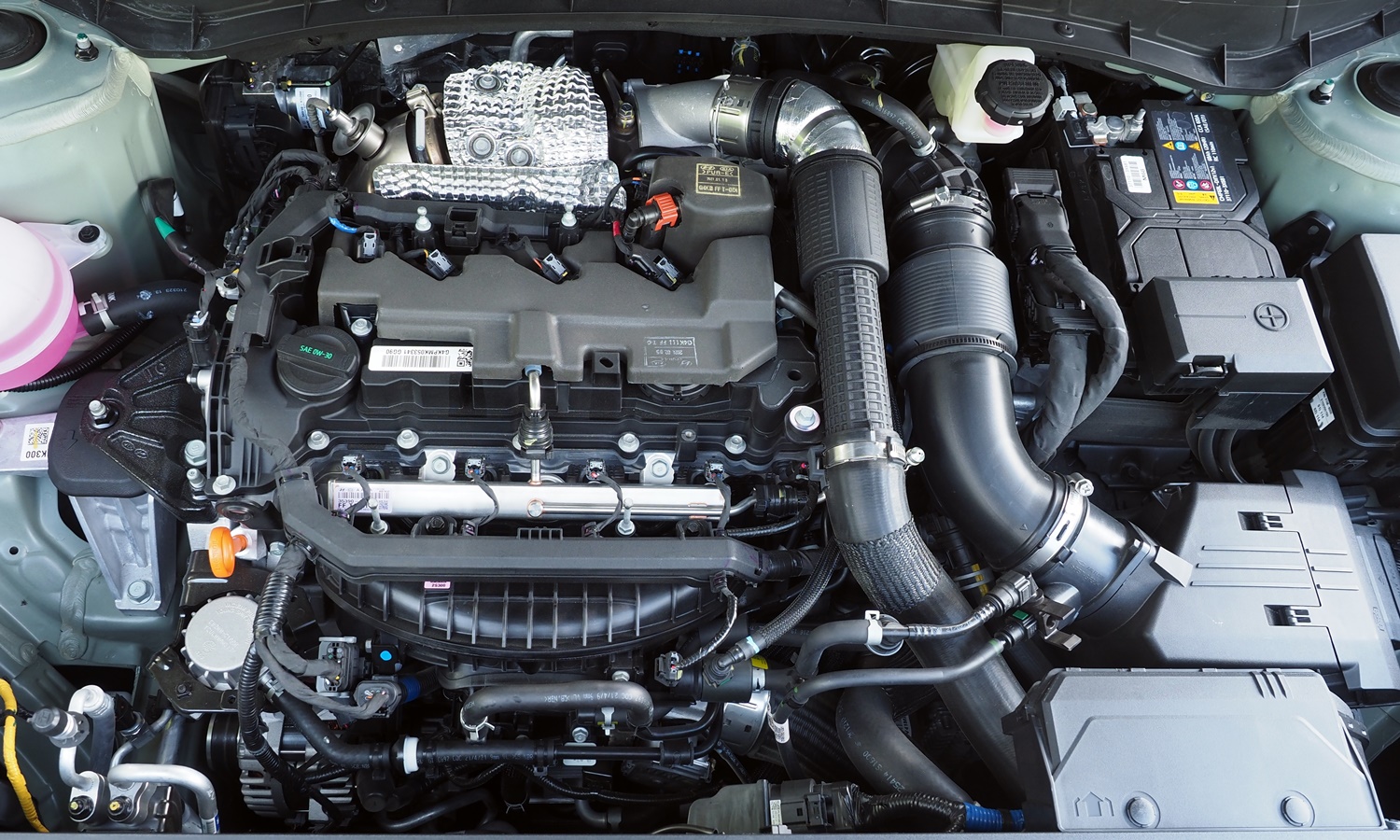
Strong engine, but meh four-cylinder noises and fuel economy.
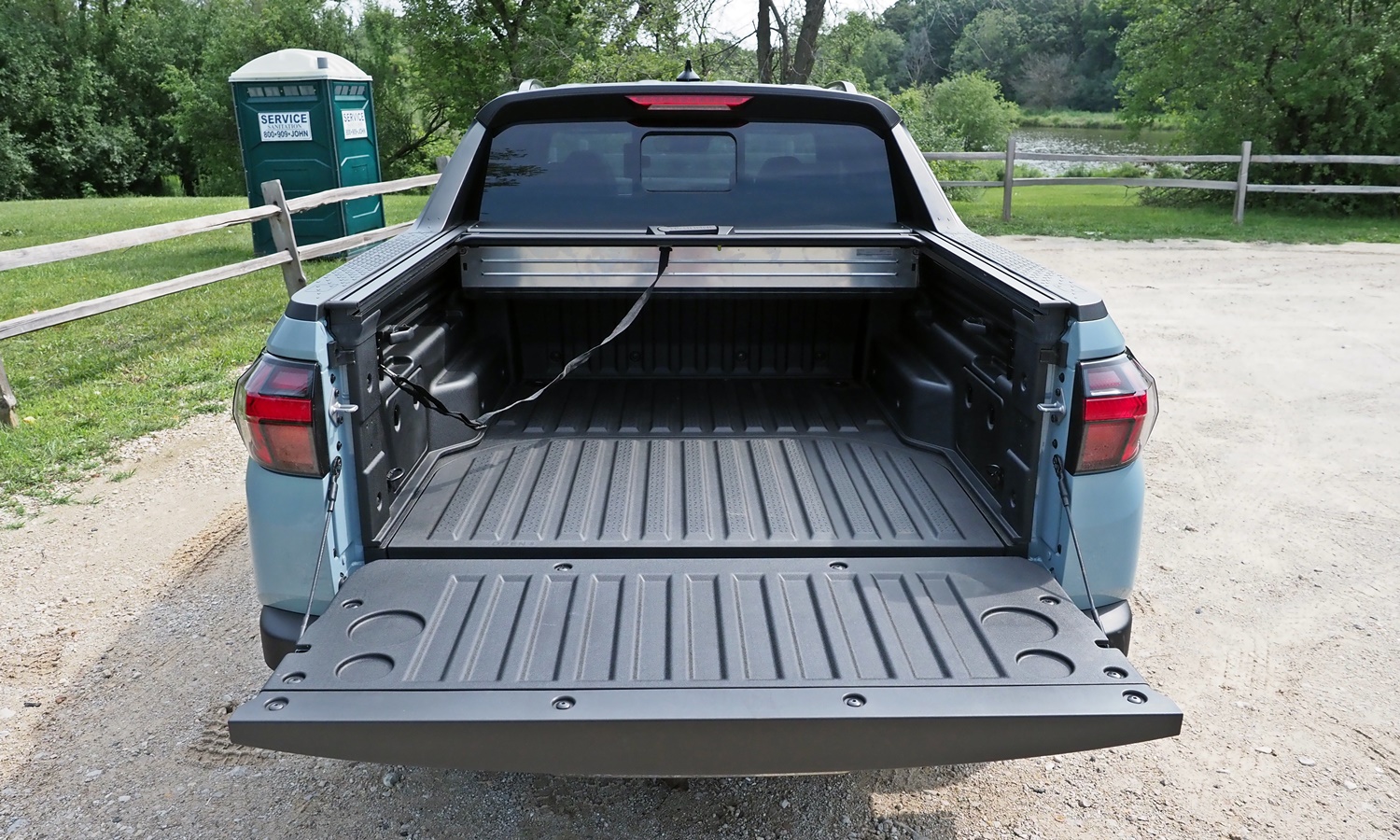
Composite bed.
See more 2022 Hyundai Santa Cruz photos
Hyundai provided insured vehicles, fuel, and food at an event for invited media.











